Chapter 1 Arithmetic Ratio And Proportions
Arithmetic Ratio and Proportions Introduction
In Class 7 you have studied the problems on ratio and proportion, time and distance, percentage, simple interest, profit and loss, square root of fractions and decimals, and also square measure. Here we shall discuss those topics in brief for recapitulations.
Ratio and proportion
Ratio: If x and y are two quantities of the same kind and the numerical value of y ≠ 0 then the fraction x/y is called the ratio of x to y and is written as x : y.
This ratio is the quotient of two quantities of the same kind.
Hence ratio is an abstract number and has no unit.
The quantities forming the ratio are called the terms of the ratio, in which the first quantity is called the antecedent while the second is called the consequent.
Proportion: A proportion is the equality of two ratios.
We say that one ratio is proportional to the other and the four numbers forming the two ratios are in proportion.
Read And Learn More WBBSE Solutions For Class 8 Maths
Some problems with ratio and proportion
Example 1
Find the ratio of 1.50 to 3.50.
Solution:
Given 1.50 And 3.50
Required ratio = ₹1.50/₹3.50
= 150P/350P
= 3/7
= 3:7
The ratio of 1.50 to 3.50 = 3:7
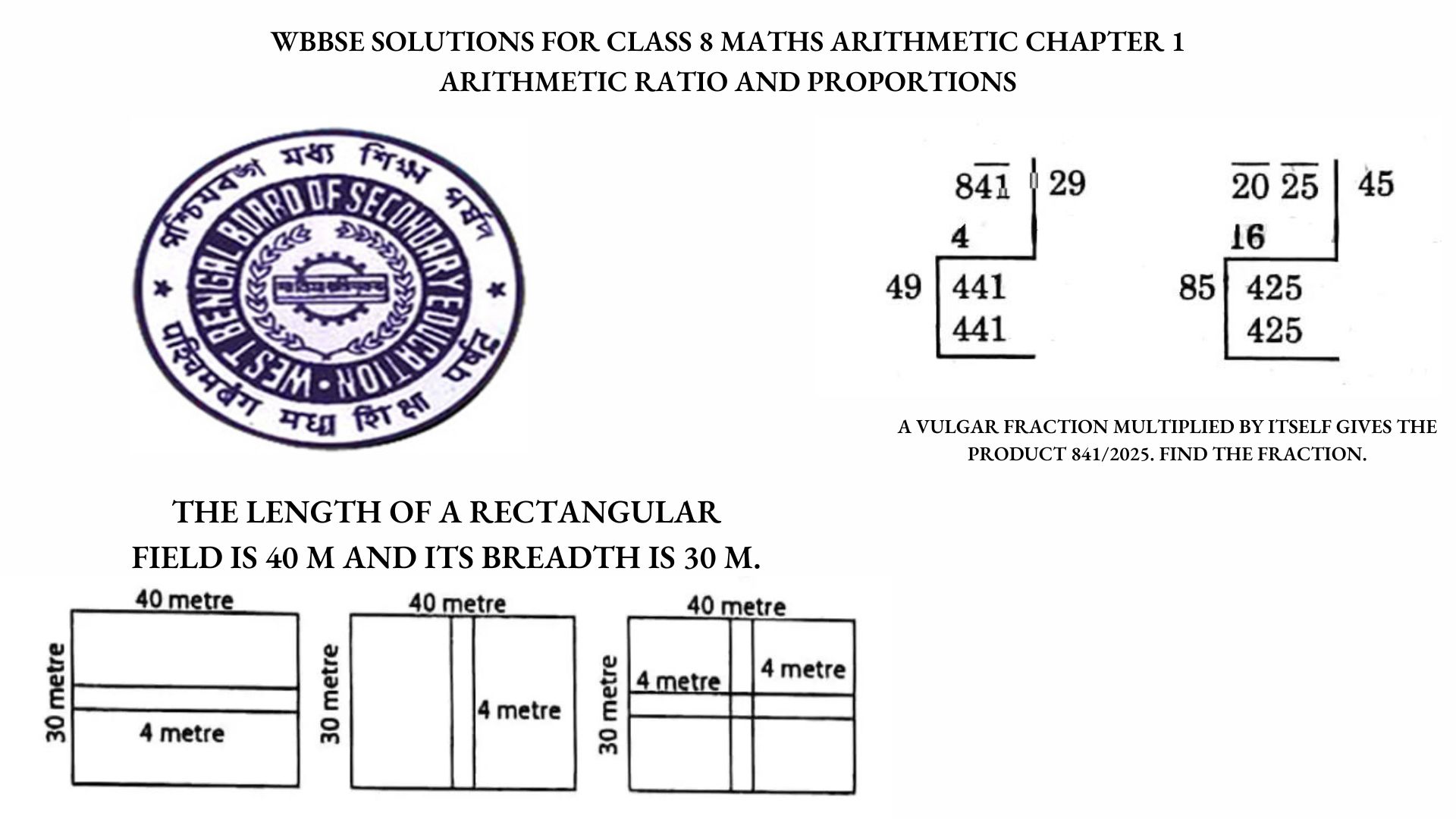 Example 2
Example 2
Find the value of x from the relation 4:7 = 12:x.
Solution:
Given
The Relation 4:7 = 12:x
From the given relation, we get,
4/7 = 12/x
or, 4 x x = 12 × 7
or, x = 12 x 7/4
= 21
The value of x is 21
Example 3
Distinguish between x ÷ y and x: y.
Solution. x ÷ y is defined even when x and y are not of the same kind.
But x:y is defined only when x and y are of the same kind.
Example 4 If A: B = 3:4 and B: C = 6: 5, then find the value of A: B: C.
Solution:
Given A: B = 3:4 And B: C = 6: 5
A: B=3:4=(3×3): (4 x 3)=9:12
B:C = 6:5
= (6x²): (5 x 2)
= 12: 10
A: B: C= 9:12:10
The value of A: B: C= 9: 12:10
Example 5
The ratio of two quantities is 5: 7. If the antecedent is 40 kg, find the consequent.
Solution:
Given
The ratio of two quantities is 5: 7
Let the consequent be x kg.
∴ 40 kg/ x kg = 5/7
or, 40/x = 5/ 7
or, x= 40 x 7 / 5
= 8 x 7
= 56
The consequent is 56 kg.
Example 6
The ratio of the ages of Ram and Shyam is 8: 7. If the age of Shyam is 21 years, find the age of Ram.
Solution:
Given
The ratio of the ages of Ram and Shyam is 8: 7
The age of Shyam is 21 years
Let the age of Ram be x years.
∴ x/21 = 8/7
or, 7x=21 x 8
or, x = 21 x 8 / 7
=24
The age of Ram is 24 years.
Example 7
The ratio of prices of two books the price of the first book is ₹ 75. If the price of the first book was ₹ 25 more, what would be the ratio of their prices?
Solution:
Given
The ratio of prices of two books the price of the first book is ₹ 75
The price of the first book was ₹ 25
Let the price of the second book be by ₹ x.
∴ 75/x = 3/1
or, x = 75/3
= 25
If the price of the first book was ₹ 25 more, then the required ratio
= 75+25/25
= 10025
= 4/1
= 4:1
∴ The required ratio of their prices would be 4:1
Example 8
The ratio of daily work of A and B is 4: 3. If A can do a work in 12 days, then find the number of days required by B to do the work.
Solution:
Given:
The ratio of daily work of A and B is 4: 3
A can do a work in 12 days
Since the ratio of the daily work of A and B is 4: 3, therefore the work done by A in 3 days is equal to the work done by B in 4 days.
∴ work done by A in 1 day
= work done by B in 4/3 days
∴ work done by A in 12 days
work done by B in 4/3 x 12 days
= 16 days
B can do work in 16 days
Example 9
Ram earns ₹ 125 in 8 days and Shyam earns ₹ 140 in 10 days. Find the ratio of their earnings.
Solution:
Given:
Ram earns ₹ 125 in 8 days and Shyam earns ₹ 140 in 10 days
The earning of Ram for 8 days = ₹ 125
∴ The earning of Ram for 1 day = ₹125/8
The earning of Shyam for 10 days = ₹140
The earning of Shyam for 1 day = 140/10
∴ The ratio of their earnings = 125/8 : 140/10
= 125/8 x 10/140
= 125:112
The ratio of their earnings is 125:112.
Example 10
A policeman starts to chase a thief. When the thief goes 5 steps, the policeman moves 6 steps. Again, 3 steps of the policeman is equal to 6 steps of the thief. Find the ratio of their speeds.
Solution:
Given:
A policeman starts to chase a thief . When the thief goes 5 steps, the policeman moves 6 steps. Again, 3 steps of the policeman is equal to 6 steps of the thief.
3 steps of the police = 6 steps of the thief
1 step of the police = 6/3 steps of the thief
6 steps of the police = 6 x 6 / 3 steps of the thief
= 12 steps of the thief
Now, at the same time, the policeman moves 6 steps and the thief moves 5 steps.
∴ the ratio of their speeds
= 6 steps of the police / 5 steps of the thief
= 12 steps of the thief / 5 steps of the thief
= 12/5
= 12:5
The ratio of their speeds is 12:5
Example 11
Find the missing term in place of * in the following proportion 16:20::8:*
Solution:
Given Proportion
16:20::8:*
Let, the missing term be x.
.. 16/20 = 8/x
or, 16 x x = 20 x 8
or, x = 20 x 8 /16
= 10
The missing term is 10.
Example 12
Find the fourth proportional of the following numbers: 12, 16, 18.
Solution:
Given 12, 16, 18….?
Let, the fourth proportional the x.
∴ 12/16 = 18/x
or, 12 x x = 18 x 16
or, x = 18 x 16 / 12
= 24
The fourth proportion is 24.
Example 13
Find the fourth proportional of 2,4 1/2 and 4.
Solution:
Given 2,4 1/2 And 4……?
Let, the required fourth proportion be x.
∴ 2 / 4 ½
or, 2x = 9/2 x 4 = 18
or, x = 18/2
= 9
The fourth proportion is 9.
Example 14
Find the third proportional of the following numbers: 9, 12,
Solution:
Given 9, 12,…..
Let, the third proportional be x.
∴ 9/12 = 12/x
or, 9x = 12 x 12 or, x= 12 x 12 / 9
= 16
The third proportion is 16.
Example 15
Find the mean proportional of the following numbers: 25, 81.
Solution:
Given Numbers 25, 81
Let, the mean proportion be x.
∴ 25/x = x/81
or, x2 = 25 x 81
or, x = 5 x 9 = 45
The mean proportional is 45
Example 16
A’s money is 2/3 of B’s money and B’s money is 4/5 of C’s money. Find the ratio of A’s money to C’s money.
Solution:
Given A’s money is 2/3 of B’s money and B’s money is 4/5 of C’s money.
Since A’s money= is 2/3 of B’s money
A’s money / B’s money = 2/3
Also, B’s money = 4/5 of C’s money
B’s money/C’s money = 4/5
A’s money/B’s money X B’s money/C’s money = ⅔ x 4/5
or, A’s money / C’s money = 8:15
A’s money: C’s money 8:15
A’s money/B’s money X B’s money/C’s money = 2/3 x 4/5
or, A’s money / C’s money = 8:15
A’s money: C’s money 8:15
Example 17
If 2/3 of A = 75% of B = 0.6 of C, then find A:B: C
Solution:
Given 2/3 of A = 75% of B = 0.6 of C
2/3 of A= 75% of B = 0.6 of C
or, 2/3 × A = 75/100 x B = 6/10 x C
or, 2/3 x A = 3/4 x B = 3/5 x C = k(say)
:. A=3k/2, B=4k/3, C=5k/3
.. A: B: C= 3k/2: 4k/3: 5k/3
= 3/2:4/3:5/3
= (3/2 x 6):(4/3 x 6) : (5/3 x 6)
=9:8:10
A: B: C=9:8:10
Example 18
Divide 7000 among A, B, and C in such a way that the ratio of their shares is 8: 12 15. Find the shares of A, B, and C.
Solution :
Given
By Dividing 7000 among A, B, and C in such a way that the ratio of their shares is 8: 12 15
Let, A will get ₹ 8x, B will get ₹ 12x and C will get ₹ 15x.
According to the question,
8x+12x+15x= 7000 or, 35x = 7000
or, x = 7000/35
= 200
∴ A will get ₹ 8×200= ₹ 1600;
B will get ₹ 12 x 200 = 2400
and C will get 15 x 200 = ₹ 3000.
A will get ₹ 1600,
B will get 2400
and C will get 3000.
Time and distance
When we travel from one place to another to cover some distance, some time is required. So to work out problems on time and distance, we have to concentrate on two main things.
1. The distance traveled and
2. the time required to travel that distance.
The relations between time, distance, and speed are as follows :
1. Distance traveled = speed x time. distance traveled
2. Speed = distance traveled/time
3. Time = distance traveled/speed
We have to remember to follow two rules:
1. When a train crosses a tree (or a telegraph post), it travels a distance equal to its own length.
2. When a train crosses a platform (or a bridge), it travels a distance equal to the sum of the lengths of the train and the platform (or bridge0)
When a boat moves on a river then we have to consider two things:
1. Speed of the boat
2. Speed of the river current
The actual speed of a boat: By actual speed of a boat we mean the distance covered by a boat in unit time in still water under the influence of oars.
Speed of a boat under the current of a river:
When the boat joint is effective along the current, then the joint effective speed = actual speed of the boat + speed of the river current.
When the boat rows against the current, then the joint effective speed = actual speed of the boat – speed of the river current.
Some problems with time and distance
Example 1
A train travels 24 km in 4 hours. What distance will it travel in 10 minutes?
Solution:
Time Distance
4 x 60 minutes 24 km
10 minutes x km (say)Since,
distance is directly proportional to the time
∴ 4 x 60 / 10 = 24/x
or, 24 x 10 / 4 x 60
= 1
1 km will it travel in 10 minutes
Alternative method:
In 4 x 60 minutes, the train travels 24 km
In 1 minute the train travels = 24/ 4x 60 km
In 10 minutes the train travels = 24 x 10 / 4 x 60 km
= 1 km
The required distance is 1 km.
Example 2
Find the time takes to travel 600 km by train whose speed is 25 km/hour.
Solution:
Distance Time
25 km 1 hour
600 km x hours (say)
Since distance is directly proportional to the time
∴ 25/600 = 1/x
or, 25x = 600 or, x= 600/25
= 24
The required time is 24 hours.
Alternative method:
The train travels 25 km in 1 hour
The train travels 25 km in 1/25 hour
The train travels 600 km in 600/25 hours
= 25 hours.
Example 3
A train of length 210 meters crosses a telegraph post in 7 seconds. Express the speed of the train in km/hour unit.
Solution:
Given
A train of length 210 meters crosses a telegraph post in 7 seconds.
When a train crosses a telegraph post, it travels a distance equal to its own length.
Time Distance
7 seconds 210 meters
60 x 60 seconds x metres (say)
Since distance is directly proportional to the time
∴ 7/60 x 60 = 210/x
or, 7x = 210 × 60 × 60
or, x = 210 × 60 × 60 / 7
= 108000
Alternative method :
In 7 seconds the train crosses 210 meters
In 1 second the train crosses 210/7 meters
In 60 x 60 seconds the train crosses 210/7 x 60 x 60 meters = 108000 meters
= 108 km
The speed of the train is 108 km/hour.
Example 4
A train crosses a platform in 30 seconds traveling at a speed of 60 km/hour. If the length of the train be 200 meters, then find the length of the platform.
Solution: When a train crosses a platform, it travels a distance equal to the sum of the lengths of the train and the platform.
Time Distance
60 x 60 seconds 60 km
30 seconds x km (say)
Since, the distance is directly proportional to time,
∴ 60 x 60/30 = 60/x
or, x x 60 x 60 = 30 x 60
or, x= 30 x 60/60 x 60 = 1/2
∴ Distance traveled by train in 30.
seconds = 1/2km
= 1/2 x 1000 metres
= 500 meters
Now, the length of the train + the length of the platform 500 meters
∴ Length of the platform = (500-200) metres = 300 metres
The length of the platform is 300 meters.
Alternative method :
In 60×60 seconds the train travels 60×1000 meters
In 1 second the train travels 60 x 1000 / 60 x 60 meters
In 30 second the train travels 60 x 1000 x 30 / 60 × 60 meters
= 500 meters
∴ Length of the platform
= (500-200) meters
= 300 meters
The length of the platform is 300 meters
Example 5
Two trains start at the same time towards each other from two stations 120 km apart. The speeds of the trains are 50 km/hour and 40 km/hour respectively. Find the distance between them after 1 hour and 15 minutes. Find also the distance between them after 2 hours. (Here assume that the two trains are traveling on parallel lines.)
Solution:
In 1 hour the distance between the two trains decreases by (50 +40) km = 90 km
Now, 1 hour 15 minutes = 1 15/60
hours = 1 1/4 hours
Hours = 5/4 hours
In 1 hour distance between the two trains decreases by 90 km
In 5/4 hours distance between the two trains
decreases by 90 x 5/4 km =
= 112.5 km
∴ The distance between them after 1 hour 15 minutes will be (120 112.5) km = 7.5 km
Again, in 2 hours the two trains advance towards each other by 90 x 2 km =180 km
:. Distance between them after 2 hours will be (180-120) km = 60 km
The distance between them after 1 hr 15 min is 7.5 km and the distance between them after 2 hours is 60 km.
Example 6
The distance between A and B along a river 15 km in 1 hour is 96 km. The speed of the river current is 4 km/hour from A towards B. A boat takes 8 hours to travel from A to B. What time will it take to return from B to A?
Solution: For the journey from A to B,
In 8 hours the boat travels 96 km
In 1 hour the boat travels 96/8 = 12 km
:. The actual speed of the boat = (12-4) km/hour = 8 km/hour
Therefore, the speed of the boat against the current (8-4) km/hour = 4 km/hour.
So, for the journey from B to A,
To travel 4 km the boat takes 1 hour
To travel 1 km the boat takes 1/4 hours
To travel 96 km the boat takes 96/4 hours
= 24 hours
The boat will take 24 hours to return from B to A.
Example 7
P and Q are two places on the bank of a river. The speed of the river current is from P towards Q. At the same time, a boat starts from P towards Q with the actual speed of 8 km/hour and another boat starts from Q towards P with an actual speed of 7 km/ hour. If the distance between P and Q be 150 km, when will the two boats meet?
Solution: Let, the speed of the river current be x km/hour.
In 1 hour the first boat covers (8 + x) km. and in 1 hour the second boat covers (7-x) km
∴ In 1 hour the distance between the two boats decreases by (8+x+7-x) km = 15 km.
The distance decreases by
15 km in 1 hour
1 km in 1/15 hour
150 km in 150/15 hours = 10 hours
The two boats will meet after 10 hours.
Example 8
Speeds of a boat along and against the respectively. Find the actual speed of the current are 12 km/hour and 8 km/hour boat and the speed of the current.
Solution:
The actual speed of the boat + speed of the current 12 km/hr
The actual speed of the boat – speed of the current = 8 km/hr
(By addition), 2 x actual speed of the boat = 20 km/hr
∴ Actual speed of the boat= 20/2 km/hr
= 10 km/hr
Speed of the current = (12 – 10) km/hr
= 2 km/hr
The actual speed of the boat is 10 km/hr.
The speed of the current is 2 km/hr.
Square root of fractions
If a decimal fraction is multiplied by itself, then the product is called the square of the decimal and the first decimal fraction is called the square root of the product.
For Example :
(0.12)2=0.12×0.12=0.0144;
hence, √0-0144
= 0.12
If a vulgar fraction is multiplied by itself, then the product is called the square of the vulgar fraction and the first vulgar fraction is called the square root of the product.
For Example :
(1/3)2 = 1/3 x 1/3
= 1/9
hence, √1/9 = 1/3
1.7 Some problems with the square root
Example 1
Find the square root of 2 up to 3 places of decimals.
Solution:
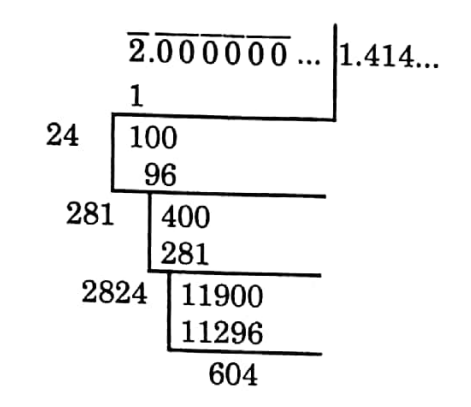
The required square root = 1.414
Example 2
Find the square root of 52-983841 correct up to two places of decimal.
Solution:
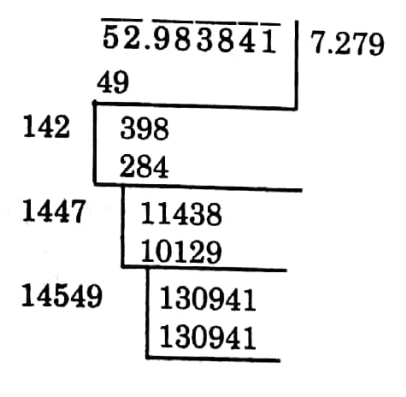
Hence, the square root of 52.983841 correct up to two places of decimal is 7.28.
Example 3
The sides of the two squares are 16.5 and 22 meters respectively. Find the side of a square whose area is equal to the sum of the areas of the two squares.
Solution:
Area of the first square =(16.5)2 sq m
= 272.25 sq m
Area of the second square =(22)2 sq m
= 484 sq m
∴ The area of the new square = (272.25 +484) sq m
= 756.25 sq m
:. Each side of the new square
=√756.25 m
= 27.5m
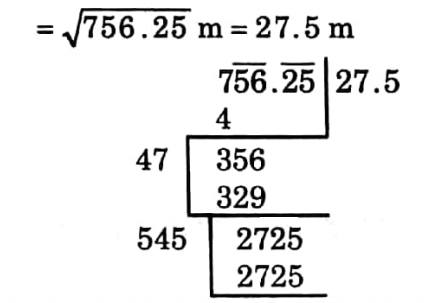
Each side of the new square is 27.5 meters
Example 4
Which number should be subtracted from 48.03 so that the square root of the difference is 5.7?
Solution:
Since, the square root of the difference is 5.7 therefore, the difference = (5.7)2
= 32.49.
Hence, the number to be subtracted = 48.03 – 32.49
= 15.54
The number to be subtracted is 15.54.
Example 5
A man spent 506.25. Each day he spent as many rupees as the number of days in which the money was spent. How much did he spend each day?
Solution:
Since the number of days and the number of rupees spent each day are equal, therefore, the product of two equal numbers = 506.25
∴ Each number = √506.25
= 22.5
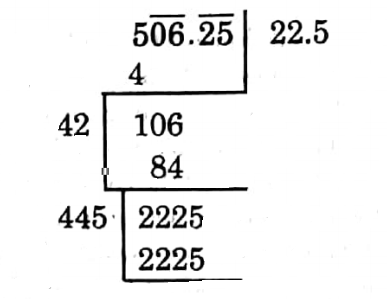
He spent ₹ 22.50 each day.
Example 6
A vulgar fraction multiplied by itself gives the product 841/2025. Find the fraction.
Solution:
Here the required vulgar fraction is the
the square root of 841/2025
= 27.5 m
Now, √841/2025
= √841/√2025 = 29/45
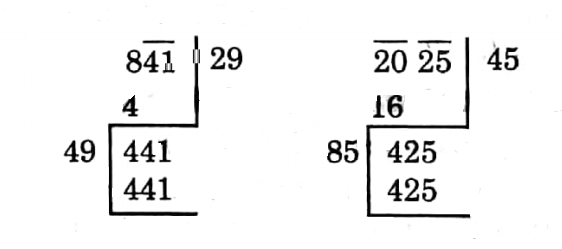
The fraction is 29/45
Example 7
The product of two numbers is 75/121 one of them is thrice the other. Find the numbers.
Solution:
Greater number x smaller number = 75/121
or, 3 x smaller number x smaller number = 75/121
or, (smaller number)2 = 75/25 3 x 121
= 25/121
or, smaller number = √25/121 = √25/√121
= 5/11
∴ Greater number = 3 x 5/11
= 15/11
= 1 4/11
The numbers are 1 4/11 and 5/11.
Example 8
Find the smallest whole number by which 64/125 should be multiplied so that the product will be a fraction which is a perfect square.
Solution:
64/125 = 8×8/5x5x5
clearly, it should be multiplied at least by 5 so that the product will be a fraction which is a perfect square.
The smallest whole number by which 64/125 should be multiplied is 5.
Example 9
308 square stones are required to pave a square of area 1925 square meters. Find the length of each side of such a stone.
Solution :
Given
308 square stones are required to pave a square of area 1925 square meters
By 308 stones 1925 sq meters are paved
By 1 stone 1925/308 sq meters is paved
= 25/4 sq meters is paved
Therefore, the area of each stone = 25/4 sq meters
Length of each side of a stone = //25/4
metres metres = 5/2 metres.
= 2 1/2 meters
The length of each side of a stone is 2 1/2 meters.
Example 10
The sides of the two squares are 12/5 meters and 9/5 meters respectively. Find the side of a square whose area is equal to the sum of the areas of the two squares.
Solution:
Given:
The sides of the two squares are 12/5 meters and 9/5 meters respectively.
The area of the first square
= (12/5)2 sq meters
= 144/25 sq meters
The area of the second square= (9/2)2 sq metres
= 81/25 sq meters
∴ Area of the new square=(144/25 + 81/25) sq metres
= 225/5 sq meters
= 9 sq meters
∴ Each side of the new square = √9 meters
= 3 meters
Each side of the new square is 3 meters.
1.8 Square measure
The plane area enclosed by straight lines is called a polygon. The measure of the portion enclosed by the sides of a polygon is called its area.
The sum of the lengths of the sides of a polygon is called its perimeter.
A quadrilateral whose opposite sides are equal and the angles are right angles is called a rectangle.
The quadrilateral whose four sides are equal and the angles are right angles is called a square.
Some useful measurements:
1. Area of rectangle Length x Breadth.
2. The perimeter of rectangle = 2 x (Length + Breadth).
3. Area of square = (Side)2.
4. The perimeter of square = 4 × Side.
5. Area of the floor of a room = Length × Breadth.
6. Area of the roof of a room = Length × Breadth.
7. Area of the four walls of a room
= 2x (Length + Breadth) x Height
= Perimeter of the floor × Height.
Some problems with square measure
Example 1
Solution:
Given:
Here, length = 15 m 25 cm = 1525 cm
breadth 10 m 2 cm = 1002 cm
∴ Area of the rectangle
= length x breadth
= 1525 x 1002 sq cm
= 1528050 sq cm
= 152 sq m 80 sq dm 50 sq cm
The area of the rectangle is 152 sq m 80 sq dm 50 sq cm
Example 2
How many tiles, each 5 dm by 2 dm will be required to cover the floor of a room 15 m by 12 m?
Solution:
The area of the floor = 15×12 sqm
= 180 sq m
= 18000 sq dm
The area of each tile = 5 dmx2 dm
= 10 sq dm
.. The number of tiles required = 18000/10 = 1800
1800 tiles will be required.
Example 3
Find the perimeter of a rectangle whose length is 15 m 5 dm and breadth is 8 m 7 dm.
Solution:
Given:
Length is 15 m 5 dm And breadth is 8 m 7 dm.
The perimeter of the rectangle
= 2 × (length + breadth)
= 2x (155+87) dm
= 2 × 242 dm
= 48 m 4 dm
The perimeter of the rectangle is 48 m 4 dm.
Example 4
One plot is 4 sq meters and another plot is 4 meters square. Which one is of the greater area?
Solution:
Given:
One plot is 4 sq meters and another plot is 4 meters square.
4 sq meters is meant a plot whose area is 4 sq meters.
By 4 meters square is meant a square plot
the length of whose side is 4 meters i.e.,
its area = (4)2 sq m = 16 sq m.
The plot 4 meters square is of the greater area.
Example 5
How much fencing will be required to fence a square field of area 625 sq meters?
Solution:
Given:
The area of the square field = 625 sq meters
∴ The length of its side = √625 m = 25 m.
Its perimeter = 4 x 25 m = 100 meters.
Since the total length of the fencing is equal to the perimeter, therefore the required length of fencing = is 100 meters.
The required length of fencing is 100 meters.
Example 6
A garden is 30 m long and 20 m broad. All around outside of it, there is a path 3 m broad. What is the area of the path?
Solution:
Given
A garden is 30 m long and 20 m broad. All around outside of it, there is a path 3 m broad.
Length of the garden including the path= (30+ 3 x 2) m
= (30+6)
= 36 m
The breadth of the garden including the path Example 9 =(20+3×2) m
= (20+6) m
= 26 m Area of the garden including the path = 36 m x 26 m
= 936 sq m
Area of the garden excluding the path = 30 m x 20 m
= 600 sq m
Area of the path = (936-600) sq m
= 336 sq m
The area of the path is 336 sq m.
Example 7
The length, breadth, and height of a room are 4 m, 3 m, and 5 m respectively. What will be the cost of cementing the floor of that room at 15 per square meter? What will be the cost of whitewashing the four walls at 5 per square meter?
Solution:
Given
The length, breadth, and height of a room are 4 m, 3 m, and 5 m respectively.
Area of the floor of the room
= 4 × 3 sq m = 12 sq m.
cost of cementing 1 sq m = ₹ 15
Cost of cementing 12 sq m = 15 x 12=180
Again, area of the four walls of the room =2x(4+3) × 5 sq m
=2x7x5 sq m
= 70 sq m
cost of whitewashing 1 sq m = ₹ 5
Cost of whitewashing 70 sq m = ₹ 5 x 70
= ₹ 350
The cost of cementing the floor is ₹180.
The cost of whitewashing the four walls is ₹ 350.
Example 8
Find the greatest measure of each stone of the same square shape to cover a rectangular courtyard 36 cm long and 28 m broad. Find the number of such stones.
Solution:
Given
The H.C.F. of 36 m and 28 m is 4 m.
∴ Each stone of the greatest area will be 4 meters square.
∴ Area of each stone = (4)2 sq m
= (4 × 4) sq m.
∴ The required number of stones
= 36 x 28 / 4 x 4
= 69
Each stone is 4 meters square and the number of stones is 63.
Example 9
What will be the cost of paper 3 m wide, at 25 paise per meter for covering the four walls of a room 15 m long 12 m broad, and 10 m high?
Solution:
Given
A paper 3 m wide, at 25 paise per meter for covering the four walls of a room 15 m long 12 m broad, and 10 m high
The area of the paper
= The area of the four walls
= 2x (length + breadth) x height
= 2 × (15 m + 12 m) x 10 m = 2 x 27 x 10 sq m
The length of the paper used 2x 27 x 10 / 3 m = 180 m
.. The required cost = 180 x 25 paise
= 4500 paise
= ₹ 45.
The required cost is ₹45.
Example 10
The length, breadth, and height of a room are equal. If the area of the four walls is 100 sq m, then find its length, breadth, and height.
Solution:
Given
The length, breadth, and height of a room are equal. The area of the four walls is 100 sq m,
Let the length of the room
= its breadth its height = a metres
∴ 2x (a + a) x a = 100
or, 2 x 2a x a = 100
or, 4a² = 100
or, a² = 100/4
=25
or, a = √25
=5
Each length, breadth, and height is equal to 5 m.
Example 11
The length of a rectangular field is 40 m and its breadth is 30 m.
1. Through the middle of this field a path of width 4 m parallel to length has divided the rectangular field into two equal parts. Find the area of the path.
2. If through the middle of this field, a path of width 4 m parallel to breadth would divide the rectangular field into two equal parts what would be the area of the path?
3. If through the middle of the field two paths parallel to length and breadth of width 4 m each would divide the rectangular field into 4 equal parts what would be the area of the path?

Solution:
1. Area of the path parallel to the length
= 40m x 4 m = 160 sq m.
2. Area of the path parallel to the breadth
= 30 m x 4 m = 120 sq m.
3. If there would be two paths through the middle of the field parallel to both length and breadth then its area would be
= 160 sq m + 120 sq m – 4 x 4 sq m
=280 sq m – 16 sq m
= 264 sq m.

